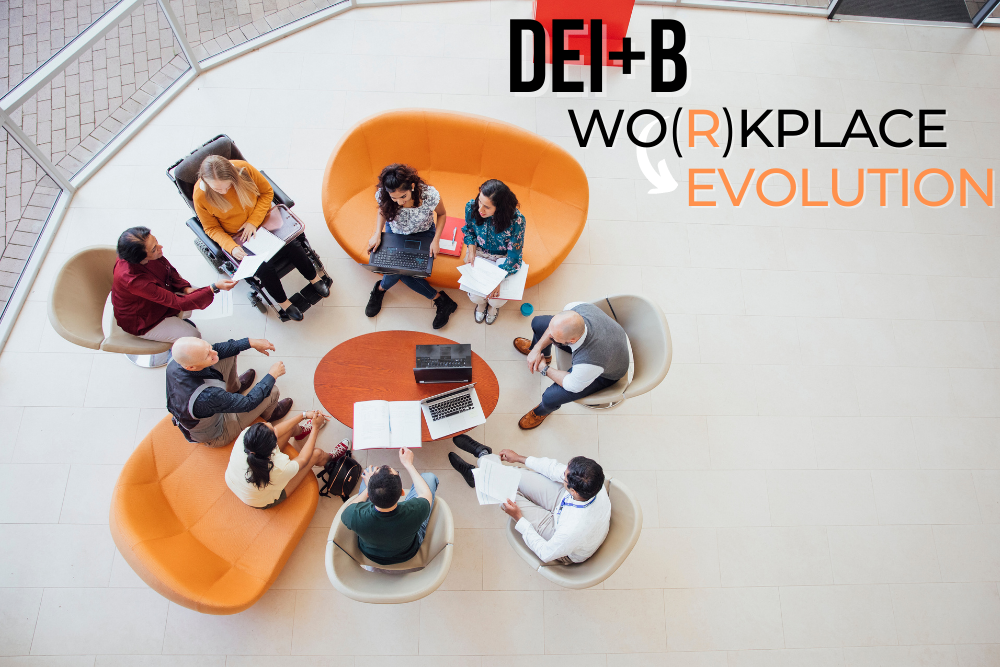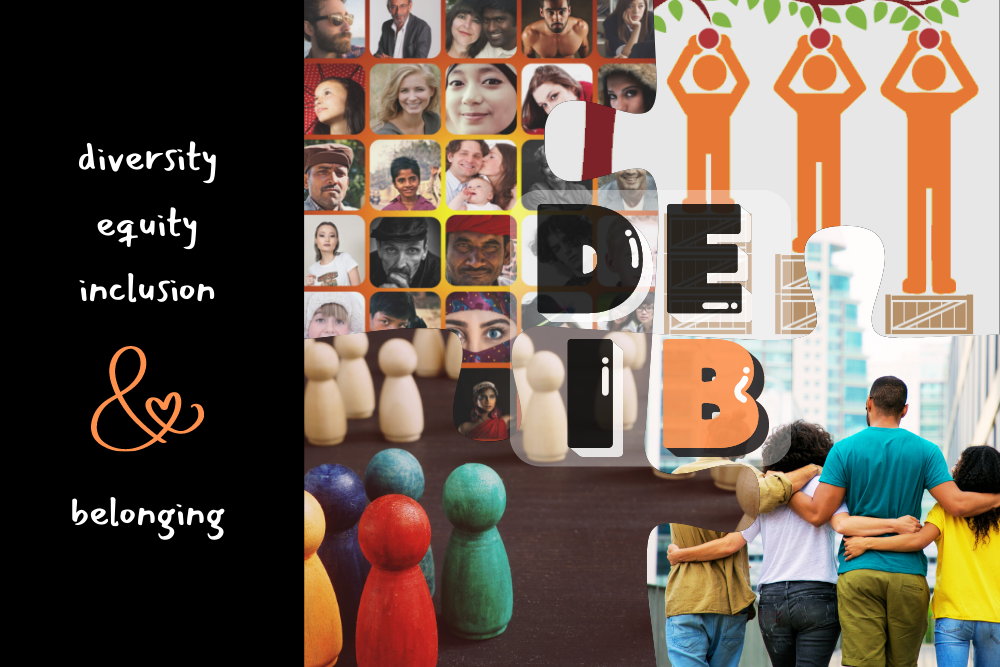There’s been a LOT of chatter about DEI (diversity, equity, and inclusion) ramping up over the past decade. Some of that has resulted in people opening up their minds and getting curious, and some of that has resulted in accentuating rifts between folks of all kinds. As with any movement or creed, there is a lot of passion behind this cause–both for the thoughtful and the misguided.
Like a baby who muddies the bathwater, it takes intentional effort to not throw out both. An ignorant execution of follow through can hinder and harm a noble cause, so if you’re simply over hearing about DEI and all its implications and agendas and are ready to tune it out, now is a good time to check in: are you throwing the baby out? If so, what might you be missing out on?
When it comes to social equity applications, finding the balance of knowledge, compassion, wisdom, and intelligent action is as easy as climbing a rock face with a blindfold on and one hand tied behind your back. But there are supports and resources out there to ensure that you are properly belted and supplied with support ropes and voices from those who can see the different angles to guide you, if you choose to fortify yourself with humility and an open mind.
You may be wondering, what does this all have to do with business? Keep reading to see how your approach matters in the workplace.
In this article:
- DEI: How It Started (a brief history)
- DEI: How It’s Going (& where that leaves us)
- DEI: Where It’s Headed
- Further Reading & Resources
DEI: How It Started (a brief history)
1900, Andrew Carnegie
At the turn of the 20th century, industrialist Andrew Carnegie founded the Carnegie School of Technology in Pittsburgh, Pennsylvania. Being a working man since his earliest teens because of the destitute nature of his family, when he became wealthy in America he turned his eye to what he could do for other folks who were experiencing hard times. Establishing a school that was accessible to one main group of students was his pet project—giving an education to the children of Pittsburgh steel workers.
In an age when child laborers were still in full swing, Carnegie was a thought revolutionary in his commitment to provide education to the underserved. He also believed that women ought to be able to learn. Overall, the school board made clear the goal of the school was to “supplement, broaden and enlarge the existing systems of education, and give their principal aid to those who are at present but partially or not at all provided for.”
While other minorities and disadvantaged groups at first weren’t within the school’s sights in particular, Andrew Carnegie was one of the first successful industrialists to respond with support to African American activists and leaders like Booker T. Washington with whom he corresponded frequently about African American matters of fairness, equality and educational funding.
1960s-1990s, Civil Rights Movement +
The history of the Civil Rights Movement and Martin Luther King Jr. is generally heralded as the tipping point of the acceleration into modern social justice reform. As described by the Greenlining Institute (2018), the focus of the movement in the 1960s into the mid 1970s was on tolerance, meaning the acceptance of integration of workplaces, schools, and communities.
From the mid 1970s into the 1990s, the focus was on multiculturalism, the legal and political accommodation of ethnic diversity, and being aware of the achievements of various racial and ethnic minorities. It also began to absorb other social platforms like gender, sexual orientation, religion, country of origin, and other identities. These emerging ideals worked to replace antiquated hierarchies, eyes set on creating reformed relations of democratic citizenship and coexistence.
BACK TO TOP
DEI: How It’s Going (& where that leaves us)
Understanding the Anger: What Gives?
You really think you aren’t racist, that person takes themselves way too seriously, your offer to help was met with incredulity, and confusing interactions flabbergast or agitate you. If you’ve experienced things like this, then congratulations–you are in an opportunistic position to reach a whole new level of intellectual acumen via understanding and growth that will serve you in the office/sales floor/job site and beyond to your everyday life.
It’s important to acknowledge the ease of getting bogged down by woke culture if you feel your existence is under attack. Once you realize that although there is a lot of maladaptive anger out there coming from people who may not truly know what change or approach is practical or even helpful, the source of that unrest is absolutely valid. Maladaptive anger issues tend to arise from an inability to deal with angry feelings in a constructive way and is “a tragic expression of unmet needs,” as noted by psychologist Marshall Rosenberg. This is why intentional UNreactionary listening to hear the subtext or the unmet needs behind the voiced grievances requires a lot of effort and developing EQ, or emotional intelligence. (See more by jumping to Gaining Intentional Wisdom)
Bumps & Bruises
Researchers and experts in the field find that there is a tendency for there to be a period of clashing when at first experiencing multiculturalism in the beginning stages, but overcoming those short-term complications has time and again shown significant gains to society. I mean, it makes sense. Change is hard, and change of this nature affects everyone involved. In order to accelerate getting to the really good part of the process, we can look and learn from what hasn’t worked, what is surface and what is substance, and pivot accordingly.
In Western Society
An interesting overall example is how there has been a shift in focus from helping people who need help and promoting healthy conversations to policing language and constructing socially sound facades without true change, or “optical allyship.”
Optical allyship: “Allyship that only serves at the surface level to platform the ‘ally,’ it makes a statement but does not go beneath the surface and is not aimed at breaking away from the systems of power that oppress.”
– Latham Thomas (10 Steps to Non-Optical Allyship by Mireille Cassandra Harper)
Speaking specifically about racism (although very much applicable in the other intersectionalities as well), linguist John McWhorter pointed out a major snag that some passionate voices have gotten stuck repeating.
We’re so focused on what people say and how they say it that we’re paying more attention to that than to the perhaps less glamorous work of getting out on the ground and trying to change society. […]
It would have looked very peculiar to [civil activists in the 60s] that we’re so concerned with what things are called. […] It’s because, to an extent, policing language is easier. Civil rights activism is not glamorous in terms of what really creates change. […]
The idea is to help people who need help. The modern idea that microaggressions and how white people feel in their heart of hearts is what we should be thinking about to me is a detour.
– John McWhorter, during an NPR interview
Although speaking life-giving words is an important part of growth and successful coexistence, some like McWhorter feel that it’s risen too high on the list of things to hone in on over other priorities.
In the Workplace
DEI has been a buzzword that many companies have started to realize they need to latch onto in order to keep up with the brand awareness trends. However, approaching true diversity needs a deep investment and commitment to genuine policy makeovers. The tagline of Inc.’s article How Companies Are Faking Their DEI Strategy and Making It Worse for Workers says it all: “While more employers truly care about diversity, equity, and inclusion (DEI), it is just a box to tick for many others.” Conducting token diversity interviews that stop DEI efforts at the hiring process, candidates feeling like they have to hide aspects of themselves to avoid bias, and skin-deep efforts to seem progressive like overly promoting persons of minorities are still big problems cited by employees surveyed and cited. (2022 DEI Throughout the Employee Lifecycle report, Lever)
Although it’s been a bit of a bumpy road, progress is the name of the game because perfection is unattainable; rather, it is the guiding light we must follow. Taking the feedback from those with certain experiences and doing some introspection on how your workplace can foster a more diverse, inclusive, and equitable environment can help any organization make significant strides. And that starts with a comprehensive and transparent DEI strategy.
Totally Worth It
DEI isn’t going away anytime soon, which is another reason to get onboard before you’re left behind. Additionally, diverse teams have proven to be more creative, solve problems faster, and increase overall business and revenue success. As the great poet Robert Frost said, “the best way out is always through.” (“A Servant To Servants”)
BACK TO TOP
DEI+B: Where It’s Headed
What It Is
Before we can know how we need to steer the ship, let’s break today’s understanding of it down. DEI is the most well-known acronym, and it has gained an extra letter to complete the concept. Diversity, Equity, Inclusion, and now B for Belonging. The purpose of this addition is to shine a light on the significance of how employees feel at work. It’s an admission that Diversity (staffing people of different social and cultural identities and lifestyles), Equity (creating structure that provide similar access vs. giving everyone the same tools), and Inclusion (ensuring all voices are heard and sit at the same table), while all crucial, aren’t enough to create equal access to opportunities and outcomes for all.
Gaining Intentional Wisdom
For an overall mindset shift or attitude adjustment, pinpointing how you can prime your brain for the gymnastics required for all the different conversations that will be required. Like other kinds of intelligence, EQ is something you can develop over time even if you don’t already have a propensity for it. Before you write this off, science backs the fact that improving your EQ is not simply beneficial for your interactions with others, but it also has noted improvements on intellectual performance, mental health, relationships, social intelligence, and surprisingly even physical health. ?
One such resource to acquire or improve this skill set is Rosenberg’s Center for Nonviolent Communication website for training, or his book that revolutionized the way yours truly approaches resolving conflict and collaborative problem solving in personal and professional settings, Nonviolent Communication: a Language of Life. This book takes the average reader four hours and 24 minutes at 250 WPM (words per minute) in its entirety, so completable on a lazy Sunday afternoon or in bouts across your busy week.
Workplace Accommodations & Application
In politics and through the pandemic, public support and demand for fair and equitable inclusion has increased as many people who had never been exposed to experiencing disability have now been introduced to this community due to the long-term effects of COVID-19. This was a catalyst for the disabled community getting into a microphone and addressing health equity, medical ableism, and medical racism. And research shows that disabled people are a vital part of your workforce (advice to help you manage) have higher levels of motivation, innovation, loyalty, and problem-solving skills; neurodiverse individuals bring improved brand image and boost company culture, as well as a unique propensity for developing creative solutions; older workers provide multigenerational wisdom and experience; racially and ethnically diverse folks supply different types of critical thinking, overlooked perspectives, and more.
The intersectionality of issues is what makes this movement so powerful and resonate with so many. With all of that in mind, how do you know what is the right approach for your company? You’ve heard of DEI, but you may have also heard of D&I, DIB, JEDI, and others… the list goes on. But one important addition to point out is DEIB–or, diversity, equity, inclusion, and belonging. Being included may be done begrudgingly, but that B piece is what breaks down barriers and helps teams to bond and develop trust and synergy.
So, how to foster DEIB in the workplace? Hop over to Collective Health for their short guide to diversity & belonging for employers to get started. (This Glossary of Definitions and Core Concepts for Diversity, Equity, and Inclusion (DEI) is also a nifty knowledge nugget source.)
BACK TO TOP
Further Reading & Ally Resources
- Disability: 10 Tips to be a Disability Ally
- Racism: 10 Ways To Be Anti-Racist
- Orientation: 10 Tips For LGBTQIA+ Allyship
- Catch-all: 10 Things Allies Can Do
Disclaimer*
*This article was written with the opinions and understandings of the author at the date and time it
was published. This author does not claim to be a spokesperson for any of the aforementioned groups
and understands that there may be future adjustments needed.
Tune in next week for the latest news in digital marketing from the Wolves’ Den.





